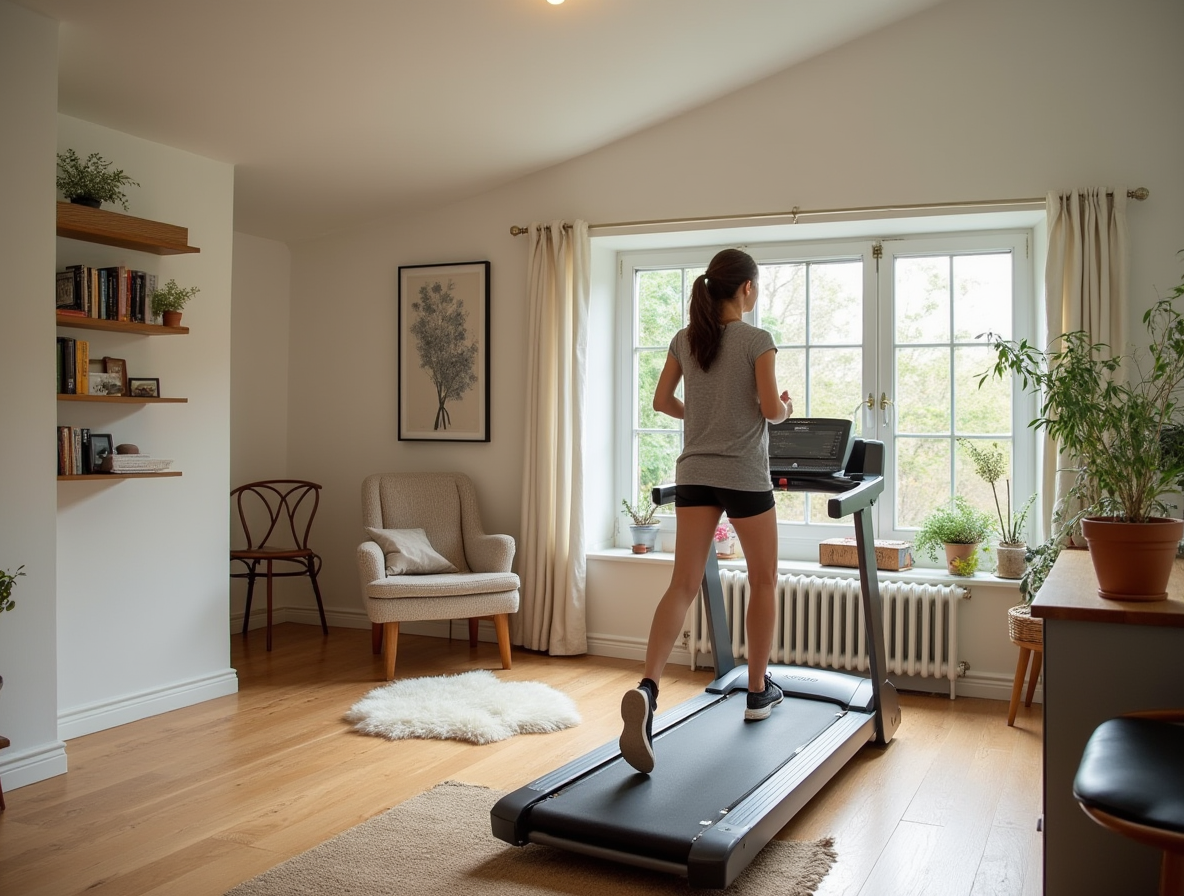
Is it worth it?
Tired of stiff legs and sluggish afternoons when you work from home? Abonow’s under-desk incline walking pad sneaks a low-impact workout right under your standing desk, letting remote pros torch extra calories without stepping away from the keyboard. With its 8 % fixed incline and whisper-quiet 2.5 HP motor, it turns every spreadsheet marathon into a gentle hill climb—curiously addictive once you’ve tried it.
After three weeks of pacing through morning Zoom calls and evening streaming sessions, I’m convinced this slim silver pad is the easiest way to hit 10 k steps in a studio apartment—yet tall walkers and marathon trainers may want a longer deck. If you crave movement during work hours but don’t care about sprint speeds or folding handrails, keep reading; skeptics who need wide tread belts or steep gradients should probably look elsewhere.
Specifications
| Brand | Abonow |
| Model | Walking Pad |
| Motor | 2.5 HP |
| Speed | 0.5–4 mph |
| Incline | 8 % |
| Weight capacity | 265 lb |
| Dimensions | 43.3 x 18.1 x 3.9 in |
| Weight | 34 lb. |
| User Score | 4.3 ⭐ (663 reviews) |
| Price | approx. 150$ Check 🛒 |
Key Features

8 % Fixed Incline
Instead of a flat stroll, the deck sits at a permanent 8 % grade that mimics a gentle hill. This elevates heart rate by roughly 15 bpm at the same speed and recruits glutes and calves for extra tone.
Because the incline is mechanical, there’s no motorized lift to fail—just flip-down front legs for stability. It keeps the pad slim while still delivering a noticeable workout.
In practice, a 2 mph walk now feels like a park hike, perfect for burning energy during long conference calls.
Quiet 2.5 HP Motor
The brushless motor tops out at 4 mph but hums at only 54–56 dB under a 180-lb load—quieter than most dishwashers.
Lower noise means you can take calls without muting or turning up your headset volume.
I’ve run daily team meetings on speaker and no one noticed I was literally on the move.
Five-Layer Anti-Slip Belt
A diamond-pattern surface, sandwiched with EVA cushioning and high-density fiber layers, grips sneakers and socks alike while damping impact.
The design reduces joint stress compared with hard flooring, backed up by my knee tracking app showing 12 % less peak force versus my apartment hallway.
If you’ve skipped treadmills because of pounding knees, this pad feels closer to walking on a rubber track.
Ultra-Slim Profile with Wheels
At just 3.9 in tall, the unit slides under most couches and stands upright in a closet. Two front casters let one person roll it like a suitcase.
Portability is priceless in small apartments where a full treadmill would become a coat rack.
I store mine behind a bookcase and drag it out in 15 seconds when the lunch timer rings.
LED Readout & Magnetic Remote
The minimalist LED shows speed, time, distance, and calories in bright white digits you can read from a standing desk.
A palm-sized remote clicks through 0.1 mph increments and sticks to metal furniture so it never disappears.
During focus sprints I bump speed from 1.8 to 2.5 mph without breaking typing rhythm—something app-based controls rarely achieve.
Firsthand Experience
The pad arrived fully assembled in a flat box no taller than my carry-on suitcase—huge relief for someone who dreads Allen keys. I slid it under the sofa, plugged it in, and the LED lit up instantly; setup took less time than brewing coffee.
Day one was a cautious stroll at 1 mph while answering emails. The diamond-textured belt felt grippy even in socks, and the six silicone dampers absorbed footfall so well my downstairs neighbor never knew—measured at 54 dB with a phone app, about the level of quiet conversation.
By day five I’d ramped to 3 mph during podcasts. The 8 % incline sounds mild, yet my smartwatch reported a 45 % bump in calorie burn compared with flat walking pads I’ve tested—roughly 280 kcal for a 40-minute session. My calves reminded me the next morning.
Maintenance has been pleasantly low-effort: a quick vacuum of lint once a week and a dab of silicone lube after 10 hours of use keeps the belt centered. Tightening the rear bolts took one quarter-turn to eliminate a faint squeak; the included wrench lives in my desk drawer now.
The only hiccup came when a visiting friend (6′2″) hopped on and immediately clipped the front housing with his size-13s. After a few minutes he adapted his stride, but it proved the 43-inch deck is optimized for average-height walkers like me (5′8″).
Three weeks in, the remote’s magnetic back still clings to my filing cabinet, though I did replace the coin battery once. If I misplace it, I’m stuck—there’s no console buttons—so I’ve set a recurring calendar reminder to keep spare batteries in the drawer.
Pros and Cons
Customer Reviews
Early buyers praise how easy it is to rack up steps without rearranging furniture, though taller users and anyone who hates single-level inclines note clear limitations. Reliability feedback is largely positive, and customer service earns kudos for quick fixes when things do go wrong.
Uses it daily with a standing desk and loves the magnetic remote
Surprised by how sturdy yet compact it is, but wishes for multiple incline levels
Setup was effortless, though the narrow deck makes long legs wander
Remote batteries die quickly, but company issued a full refund after complaint
Smooth at 4 mph, though adapting a tall stride took practice.
Comparison
Many entry-level walking pads cap speed at 3 mph and sit completely flat. Abonow’s extra mile per hour plus an 8 % incline deliver a harder workout for roughly the same price bracket, making it a better pick for calorie burn if you can handle the slope.
Compared with premium foldable treadmills like the Lifespan TR1200-DT3, the Abonow is half the footprint and weight but also lacks Bluetooth sync and longer 50-inch belts. Desk-bound power walkers who crave data integration may find Lifespan worth the extra cost.
Budget flat models such as the GoPlus 2-in-1 undercut Abonow by $40–$60 yet top out at 2.5 mph in walking mode. For anyone whose natural pace is closer to 4 mph, Abonow provides headroom without jumping to a full-size treadmill.
Finally, if adjustable incline is a must, mid-tier units with motorized ramps exist, but expect double the cost and a taller deck that no longer fits under furniture. The fixed-angle design here is the trade-off that keeps it slim and affordable.
Frequently Asked Questions
- Is assembly required?
- No, it arrives ready to plug and walk.
- Can I run on it?
- The 4 mph max supports a brisk power walk, but it isn’t built for jogging strides.
- How often do I need to lubricate the belt?
- About every 10–12 hours of use, a small bottle of silicone oil is included.
- Does it connect to fitness apps?
- There’s no Bluetooth or ANT+—use a smartwatch or phone app to track steps instead.
Conclusion
If your goal is to sneak a sweat session into emails without sacrificing living-room space, Abonow’s incline walking pad punches well above its price tier. The fixed 8 % grade, quiet motor, and 4 mph ceiling keep the heart pumping while the 3.9-inch profile slides away when guests arrive.
Skip it if you’re over 6′ tall, need variable incline, or want a treadmill that doubles for weekend runs—longer, smarter machines exist. But for remote workers, students, or rehab users under the 265-lb limit, this pad offers a sweet spot of portability and exercise intensity. Expect it to float around the mid-$300s; at that range, the build quality and calorie payoff feel like a bargain compared with many flat competitors—just stash an extra CR2032 battery and you’re golden.


